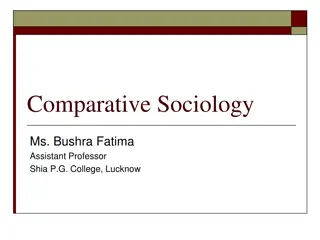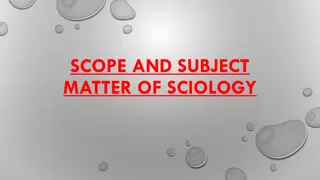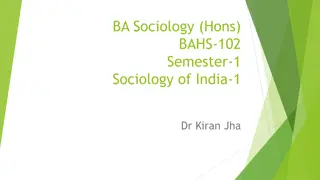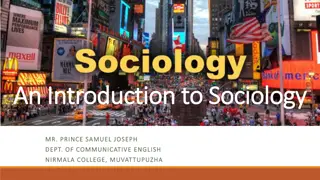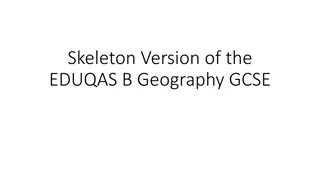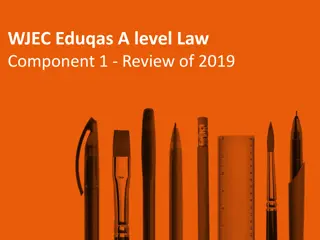
GCSE Sociology Assessment: Component 2 Overview and Guidance
Explore the assessment objectives and content structure of Component 2 in WJEC Eduqas GCSE Sociology. Learn how to demonstrate knowledge, apply theories, and evaluate evidence in social stratification and differentiation topics. Get insights into assessment criteria, marking schemes, and exemplar materials to excel in your sociology studies.
Download Presentation

Please find below an Image/Link to download the presentation.
The content on the website is provided AS IS for your information and personal use only. It may not be sold, licensed, or shared on other websites without obtaining consent from the author. If you encounter any issues during the download, it is possible that the publisher has removed the file from their server.
You are allowed to download the files provided on this website for personal or commercial use, subject to the condition that they are used lawfully. All files are the property of their respective owners.
The content on the website is provided AS IS for your information and personal use only. It may not be sold, licensed, or shared on other websites without obtaining consent from the author.
E N D
Presentation Transcript
Assessing WJEC Eduqas GCSE Sociology
Assessing evidence Please read the qualification overview PowerPoint first. This PowerPoint focuses on applying the marking criteria in GCSE Sociology component 2 You will also need access to the following documents: relevant marking schemes exemplar materials. GCSE syllabus
Assessing evidence Assessment Objectives Here are the assessment objectives for this specification. Learners must: AO1 Demonstrate knowledge and understanding of sociological theories, concepts, evidence and methods. AO2 Apply knowledge and understanding of sociological theories, concepts, evidence and methods. AO3 Analyse and evaluate sociological theories, concepts, evidence and methods in order to construct arguments, make judgements and draw conclusions.
Assessing evidence Assessment Objectives The table below shows the weighting of each assessment objective for each component and for the qualification as a whole. In each examination series, a minimum of 15% of the available marks will be awarded for learners' knowledge and understanding in relation to Research Methods.
Component 2 Content Part 1 Q 3,4 and 5 Social Stratification and Differentiation 49 marks total. Suggested time 1 hour Part 2 - Q1 Knowledge and Understanding 4 marks Q2 and 7 = Applied Research Methods 17 marks Q6 Crime and Deviance 30 marks 51 marks total. - Suggested time 1 hour
Assessing evidence Social Stratification and Differentiation Questions from within the three questions 3,4 and 5 which form this part of the component are assessed out of 2,4 and 9 marks. Questions assessed which offer 2 or 4 do not contain marks for AO3. They assess either AO1 or AO2.
Assessing evidence Social Stratification and Differentiation Knowledge and Understanding AO1 An example of this would be below. Describe what is meant by moral panic. [2] Award one mark for a basic explanation suggesting that it is when the media put a lot of attention on an issue and exaggerate it. Award one further mark for a more developed explanation or development. The mark scheme suggests possible indicative content, but generally developed explanations are required to achieve full marks.
Assessing evidence Social Stratification and Differentiation Application of Knowledge and Understanding AO2 An example of this would be below. Explain two reasons why some people experience poverty in the UK today. [4] 2 marks available for each reason explained and applied to the question. If more than two reasons are given, the best two should be assessed. Award one mark for each reason identified and a further mark for development or examples.
Assessing evidence Social Stratification and Differentiation 9 mark questions award 3 marks for each of AO1, AO2 and AO3 Assess Marxist views of social class. [9] In your answer you are advised to consider different sociological ideas and theories to support your judgement. Many answers may present accurate and detailed knowledge, but fail to meet criteria for AO2 and more often AO3. It is important to recognise that this is GCSE and candidates should be given recognition for attempts at analysis and evaluation, whilst accepting that this may not be lengthy.
Assessing evidence Question 1 is a knowledge based matching exercise worth 4 marks. Question 2 is a research methods question using knowledge of how to interpret data. 6 marks for AO1. Crime and Deviance There are questions worth 2 and 5 marks which are awarded for AO1. 8 mark questions are 4 marks for AO1 and 4 for AO2. 15 mark questions award 4 marks for AO1, 3 for AO2 and 8 for AO3 Applied Research Methods These questions are worth 11 in total which may include questions worth 1,2 and 4 marks awarded for AO2 and therefore require accurate application of knowledge and understanding. The debate question is worth 6 marks which are divided equally between AO2 and AO3.
Assessing evidence Assessment Criteria Amend this slide to fit your subject Amplification of band qualifiers in all bands with examples E.g. what does sound mean in practice? Or what is clear analysis as opposed to some analysis? These are top band descriptors for a 15 mark question which shows the high levels needed to achieve this band. It is possible that candidates may reach higher bands for AO1 and AO2, but not for AO3.
Assessing evidence Characteristics of a successful response AO1 Knowledge and Understanding Candidates should show detailed and accurate knowledge of sociological theories, concepts and/or evidence. There should be consistent use of subject language throughout the answer. AO2 Application of Knowledge and Understanding Candidates should refer to the question regularly and include phrase such as This shows that , This supports the view that , Functionalists/ New Right/Marxists would argue that . Stronger answers will also illustrate or support their argument with examples from the news or case studies.
Assessing evidence Characteristics of a successful response AO3 Analysis and Evaluation Candidates should attempt to offer evaluative comments and note the strengths and weaknesses of different arguments. They should also compare other viewpoints or interpretations. Useful phrases which may aid evaluation include connectives to balance their judgement. However On the other hand More importantly Nonetheless Furthermore Moreover Additionally But Finally What this demonstrates/highlights is An example to demonstrate this is
Assessing evidence Characteristics of a successful response AO3 Analysis and Evaluation Band 1 is characterised by limited, Band 2 by partial and band 3 by developed analysis and evaluation. In the case of a 15 mark question on crime, there is a further differentiation with Band 3 requiring good analysis and evaluation. Marking in general Choosing the correct band is the first stage in marking the questions with higher marks. In particular, this will help in awarding marks for 15 mark questions. Once the band has been decided then the specific mark can be decided for each Assessment Objective.
Exemplar material Read the script below for commentary on these answers from 2019. 2. Look at the following information and answer the questions that follow. A guide to the Minimum Wage in the UK, 2018 Adapted from livingwage.org.uk What age group? Under 18 18 to 20 21 and above 25 and above The Minimum Wage (per hour) 4.20 5.90 7.38 7.83 (c) Describe two patterns or trends shown in the table supporting your answer with reference to the statistics in the table. [4]
Exemplar material c) Describe two patterns or trends shown in the table supporting your answer with reference to the statistics in the table. [4] Student answer One pattern shown by the data is that there is an increase in wages as you get older. Under 18 s have a minimum wage of 4.20 while over 25 s have minimum wage of 7.83. Another pattern is shown that as you go up every age group the increase in minimum wage decreases. Under 18 s to 18-20 have a difference of 1.70 whereas 21 and above to 25 and above, have a minimum wage difference of 45p. So the amount of the increase in wage is less with every step up the age group.
Exemplar material Question 3 Social differentiation and stratification 3. (c) Discuss reasons why some age groups may face discrimination in the UK. [9] Student answer 2nd paragraph The elderly may face discrimination due to ideas that are preconceived. As the elderly are seen as feeble and incompetent with technology, they are discriminated against when it comes to finding work. This is because they are seen as unskilled with technology. However, some companies intentionally hire older people to give employment chances, such as Barclays scheme to assist older people with returning to work and even offers apprenticeships.
Exemplar material Question 3 Social differentiation and stratification 3. (c) Discuss reasons why some age groups may face discrimination in the UK. [9] Student answer 3rd paragraph The elderly have to pay more expensive life insurance than younger people or my not be offered it. They also face discrimination at work as they are seen as more prone to illness. Lack of life insurance may limit their ability to take part in certain activities, making them socially excluded. This is made worse by employers who do not want to employ them in case they take a lot of time off sick which costs the employer money. This makes them discriminated as consumers and workers.
Exemplar material Question 6 Crime and Deviance (b) Describe how social control works in society. [5] Student answer Social control is a process by which norms and values are enforced. Informal social control is performed by the family and education as they give sanctions ( rewards or punishments) to reinforce society norms and values, to ensure that they are a law abiding citizen. However, when informal social control fails formal social control is implicated. This refers to government institutions such as prison which is used to reiterate and ensure one is reformed and act according to norms.
Exemplar material Question 6 Crime and Deviance (d) Crime is mainly committed by young working-class males. Do you agree with this view? [15] In your answer you are advised to refer to sociological arguments and ideas to support your judgement.
Exemplar material Question 6 Crime and Deviance (d) Crime is mainly committed by young working class males. Do you agree with this view? [15] In your answer you are advised to refer to sociological arguments and ideas to support your judgement. Student answer Opening argument Crime statistics show that crime is usually committed by young working class males. This is affirmed by Merton s strain theory. This suggests that crime is committed by the working class because of the strain between one s goals and how they achieve it. This leads to them adopting a strain to anomie by which they do whatever allows them to achieve their goal, for example crime. This explains why working class commit crime.
Exemplar material Question 6 Crime and Deviance (d) Crime is mainly committed by young working class males. Do you agree with this view? [15] In your answer you are advised to refer to sociological arguments and ideas to support your judgement. Student answer evaluative edge However, Slapper and Tombs identified two forms of crime, white collar and corporate crime. They suggested that corporate crime was less likely to be detected due to the power of the company. This is illustrated by the expenses scandal in the UK. This shows that crime is committed by people of other classes as well as the working class.
Assessing evidence Characteristics of a less successful response No use of sociological terminology Failure to address the actual question Repetition of points Inaccuracies Irrelevant information Not using paragraphs for essays and even 4 mark questions Failure to address the skills of analysis and evaluation
Assessing evidence POTENTIAL PROBLEM AREAS / WHAT NOT TO REWARD POTENTIAL PROBLEM AREAS / WHAT NOT TO REWARD Question 2 expects candidates to spot patterns or trends in the data, but does not require or award marks for their interpretation of possible meanings of this, however sociological they may be. Question 6 - There are a lot of marks on the Crime 15 mark questions for AO3. Candidates need to do very well to get into Band 3 and 4 offering an evaluative edge through the essay. However, candidates should receive some award in Band 1 or 2 for some attempt at evaluation, even if they are not highly skilled. Many candidates attempt no evaluation at all. Question 7 is an Applied Research Methods question. Suggestions of research methods to be used by candidates should be logical to gain credit. Some candidates will make inappropriate choices, but still may be awarded some credit for attempting to apply reasons to follow up questions. Candidates should be specific about the exact method they suggest using, e.g. structured interview rather than just interview to gain a mark.
Any Questions? If you have any questions, contact our specialist subject officers and administrative support team for your subject with any queries. GCSESociology@eduqas.co.uk

